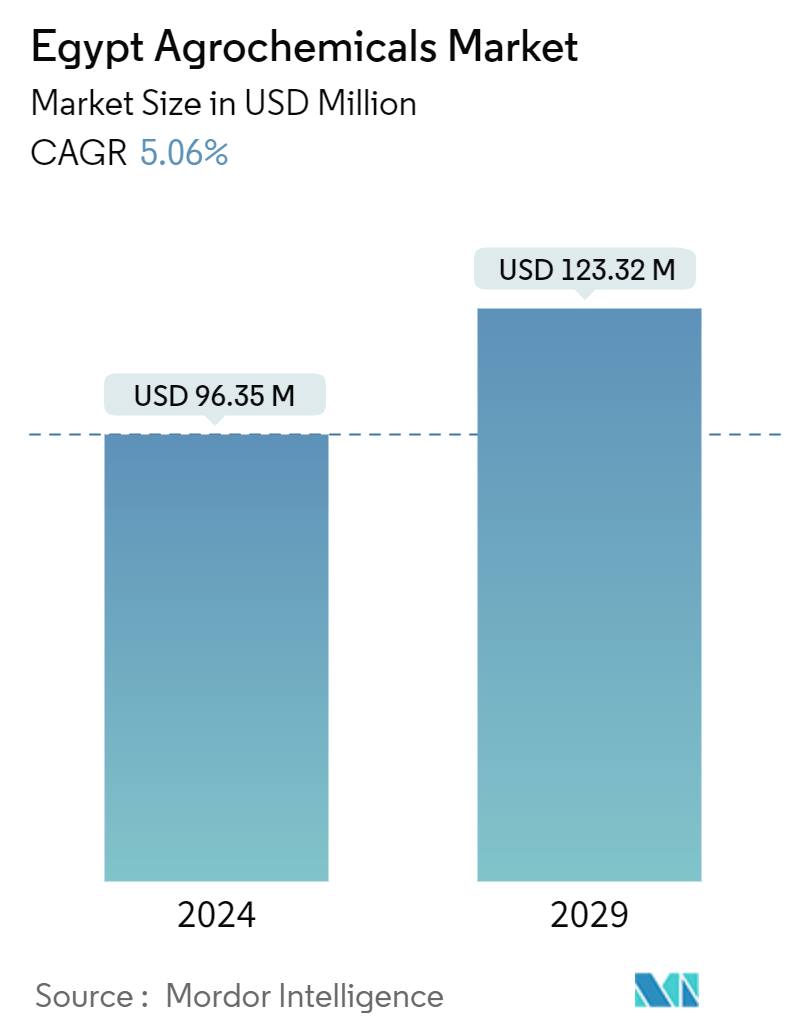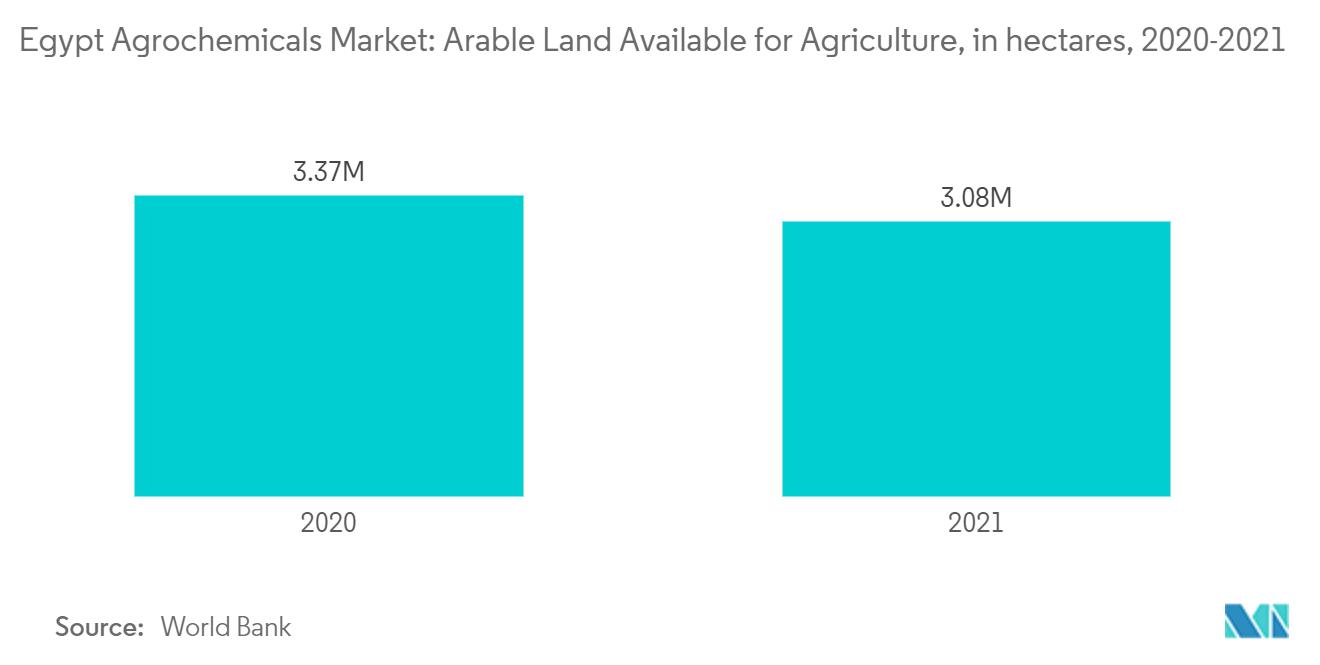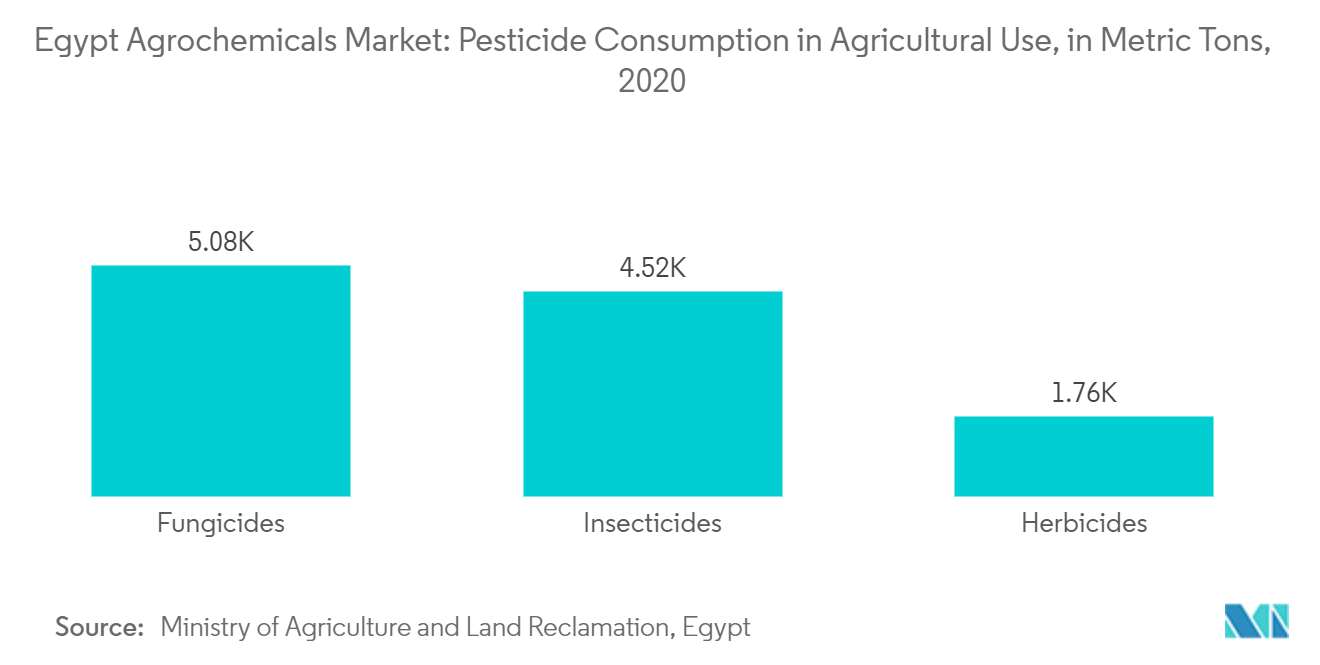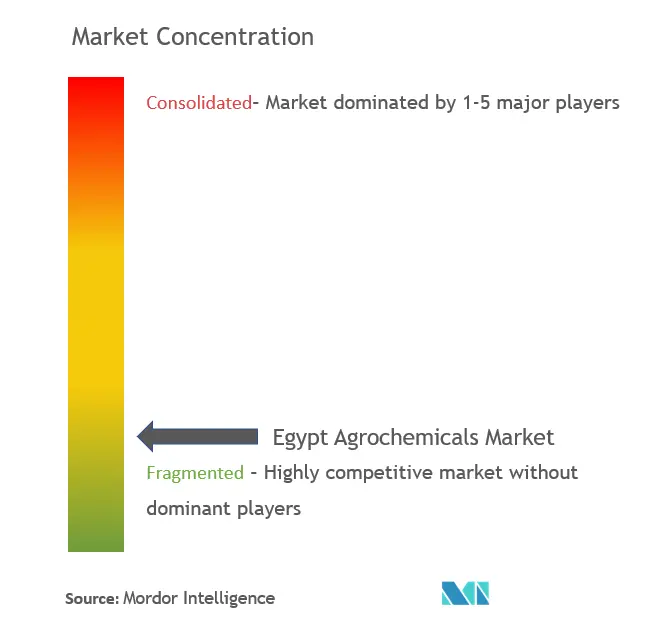Egypt Agrochemicals Market Size

| Study Period | 2019 - 2029 |
| Base Year For Estimation | 2023 |
| Market Size (2024) | USD 96.35 Million |
| Market Size (2029) | USD 123.32 Million |
| CAGR (2024 - 2029) | 5.06 % |
| Market Concentration | Low |
Major Players
*Disclaimer: Major Players sorted in no particular order |
Egypt Agrochemicals Market Analysis
The Egypt Agrochemicals Market size is estimated at USD 96.35 million in 2024, and is expected to reach USD 123.32 million by 2029, growing at a CAGR of 5.06% during the forecast period (2024-2029).
Agriculture is one of the prominent sectors of Egypt's economy. According to the Ministry of Planning and Economic Development, agriculture contributes 15% to the country's GDP. This agricultural land is shrinking rapidly due to growing urbanization in the country, followed by a reduction of land fertility due to rising sea levels (1.6 millimeters per annum), resulting in the salinization of the farmland, as reported by NASA Earth Observatory. Therefore, increasing the adoption of agrochemicals like fertilizers, plant growth regulators, and pesticides is expected to boost the productivity of available arable land.
The availability of land for agriculture is highly constricted in Egypt. For instance, the available arable land in the country is 4% of the total country's land, as reported by World Bank Open Data in 2021. This fertile land is also due to the Nile River that flows in the country. Thus, the need to improve efficiency through agrochemicals like fertilizers has been driving the agrochemical demand in the country. Some of the major crops in the country are wheat, beans, and fruits, which are more susceptible to pests and diseases, hence increasing the usage of pesticides.
Moreover, the country depends on imports of agrochemicals from various countries to meet its domestic demand and improve agricultural productivity. For instance, the country has imported pesticides valued at USD 228 million, of which 50% is contributed by China and India. This country's use of pesticides signifies the role of pesticides in agriculture production.
The availability of land for agriculture is highly constricted in Egypt. For instance, the available arable land in the country is 4% of the total country's land, as reported by World Bank Open Data in 2021. This fertile land is also due to the Nile R that flows in the country. Thus, the need to improve efficiency through agrochemicals has been driving the demand for agrochemicals.
Egypt Agrochemicals Market Trends
High Usage of Agrochemicals in Grains and Cereals is Expected to boost Production
Egypt's heightened production of grains and cereals, including rice, wheat, maize, and sorghum, has led to a pesticide and fertilizer application surge. These crops are primarily grown in the lower Nile River valley and the Nile Delta. In 2022, Egypt's wheat production stood at 9.7 million metric tons, with maize production at 5.8 million metric tons, as reported by the Food and Agriculture Organization. Such robust production figures underscore the heightened demand for fertilizers and pesticides, bolstering the market.
According to the World Bank, the county's arable land in 2021 stood at 3,077 thousand hectares, marking an 8.5% decline from the previous year's 3,365 thousand hectares. In the same period, the population of the country increased from 107 million to 109 million, reflecting the pressure on the agricultural sector. Therefore, the country is relying on the usage of fertilizers like urea, ammonium nitrate, ammonium sulfate, and calcium nitrate to improve the productivity of the available arable land for the production of staple grains like rice and wheat. Moreover, Egyptians rely on Baladi bread as a staple in their daily diet, and hence, farmers grow wheat in their farms. Farmers with small land holdings are using more agrochemicals to boost land productivity.

Increasing Use of Pesticides Due to Rising Pest Infestation
Pesticides are the major agrochemicals used for plant protection purposes. However, the country is highly import-dependent, as 75% of the pesticide demand is fulfilled by imports. Egypt imports pesticides from 27 countries. According to the Observatory of Economic Complexity (OEC), in 2022, Egypt ranked as the 50th largest importer of pesticides and 65th largest exporter of pesticides. The country exports pesticides to Sudan, Iraq, Libya, and Jordan. In 2022, pesticide exports stood at USD 16.7 million, and Sudan imported one-fourth of the total pesticide exports.
The country has made a committee known as the Agricultural Pesticides Committee under the Ministry of Agriculture and Land Reclamation. It is a vital organization responsible for assessing, evaluating, registering, regulating, and overseeing agricultural pesticides. For instance, the primary insect pests affecting cereal crops in Egypt include the greenbug (Schizaphis graminum), the corn leaf aphid (Rhopalosiphum maidis), and the Sitobion avenae aphid. These pests can significantly impact crop health and yield. This is fueling the country's farmers' demand for pesticide usage.

Egypt Agrochemicals Industry Overview
The Egyptian agrochemicals industry is fragmented and dominated by several foreign players. The major players in the market include Bayer Crop Science, BASF SE, Corteva Agriscience, Kafr El Zaytat Pesticides and Chemicals, and Abu Qir Fertilizers and Chemicals Industries hold a significant share in the market, followed by other players. Companies are continually investing in their R&D and expansion of production to introduce new products to the market and fulfill crop requirements in the country.
Egypt Agrochemicals Market Leaders
-
BASF SE
-
Bayer Limited Egypt, LLC
-
Corteva Agriscience AG
-
Abu Qir Fertilizers and Chemicals Industries
-
Kafr El Zaytat Pesticides and Chemicals.
*Disclaimer: Major Players sorted in no particular order

Egypt Agrochemicals Market News
- June 2024: The Misr Fertilizers Production Company (MOPCO) partnered with Scatec, a Norwegian Company, to build a green ammonia production plant that produces 150 thousand metric tons in Damietta, Egypt. The Egyptian government supported the project and invested USD 10 million.
- March 2022: The Misr Fertilizers Production Company (MOPCO), which produces 2 million metric tons of urea annually, expanded its existing ABB DCS (distributed control system) to the latest version to optimize its operational efficiency, maximize uptime, and minimize downtime.
Egypt Agrochemicals Market Report - Table of Contents
1. INTRODUCTION
- 1.1 Study Assumptions and Market Definition
- 1.2 Scope of the Study
2. RESEARCH METHODOLOGY
3. EXECUTIVE SUMMARY
4. MARKET DYNAMICS
- 4.1 Market Overview
-
4.2 Market Drivers
- 4.2.1 Decreasing Arable Land and Need for Increased Crop Productivity
- 4.2.2 Increasing Use of Pesticides Due to Rising Pest Infestation
- 4.2.3 Government Initiatives are Boosting Agrochemicals Market
-
4.3 Market Restraints
- 4.3.1 Restriction or Ban on Usage of Hazardous Agrochemicals
- 4.3.2 Environmental Degradation Due to Usage of Agrochemicals
-
4.4 Porter's Five Forces Analysis
- 4.4.1 Bargaining Power of Buyers
- 4.4.2 Bargaining Power of Suppliers
- 4.4.3 Threat of New Entrants
- 4.4.4 Threat of Substitute Products
- 4.4.5 Intensity of Competitive Rivalry
5. MARKET SEGMENTATION
-
5.1 Product Type
- 5.1.1 Fertilizers
- 5.1.2 Pesticides
- 5.1.3 Adjuvants
- 5.1.4 Plant Growth Regulators
-
5.2 Type
- 5.2.1 Crop-based
- 5.2.1.1 Grains and Cereals
- 5.2.1.2 Pulses and Oilseeds
- 5.2.1.3 Fruits and Vegetables
- 5.2.2 Non-crop-based
- 5.2.2.1 Turf and Ornamental Grass
- 5.2.2.2 Other Non-crop-based
6. COMPETITIVE LANDSCAPE
- 6.1 Most Adopted Strategies
- 6.2 Market Share Analysis
-
6.3 Company Profiles
- 6.3.1 Bayer Limited Egypt LLC
- 6.3.2 BASF SE
- 6.3.3 Corteva Agriscience AG
- 6.3.4 Kafr El Zaytat Pesticides and Chemicals
- 6.3.5 Abu Qir Fertilizers and Chemicals Industries
- 6.3.6 Chitosan Egypt
- 6.3.7 Evergrow Fertilizers
- 6.3.8 Yara International
- 6.3.9 Misr Fertilizers Production Company (MOPCO)
- 6.3.10 Helwan Fertilizers Co. (HFC)
- *List Not Exhaustive
7. MARKET OPPORTUNITIES AND FUTURE TRENDS
** Subject To AvailablityEgypt Agrochemicals Industry Segmentation
Agrochemical refers to biocides (pesticides including insecticides, herbicides, fungicides, and nematicides) and synthetic fertilizers. It may also include hormones and other chemical growth agents.
The Egyptian agrochemicals market is segmented by product type (fertilizers, pesticides, adjuvants, and plant growth regulators) and application (crop-based and non-crop-based). The report offers market size and forecast values (USD) and volume (metric tons) for all the above segments.
| Product Type | Fertilizers | |
| Pesticides | ||
| Adjuvants | ||
| Plant Growth Regulators | ||
| Type | Crop-based | Grains and Cereals |
| Pulses and Oilseeds | ||
| Fruits and Vegetables | ||
| Type | Non-crop-based | Turf and Ornamental Grass |
| Other Non-crop-based |
Egypt Agrochemicals Market Research FAQs
How big is the Egypt Agrochemicals Market?
The Egypt Agrochemicals Market size is expected to reach USD 96.35 million in 2024 and grow at a CAGR of 5.06% to reach USD 123.32 million by 2029.
What is the current Egypt Agrochemicals Market size?
In 2024, the Egypt Agrochemicals Market size is expected to reach USD 96.35 million.
Who are the key players in Egypt Agrochemicals Market?
BASF SE, Bayer Limited Egypt, LLC, Corteva Agriscience AG, Abu Qir Fertilizers and Chemicals Industries and Kafr El Zaytat Pesticides and Chemicals. are the major companies operating in the Egypt Agrochemicals Market.
What years does this Egypt Agrochemicals Market cover, and what was the market size in 2023?
In 2023, the Egypt Agrochemicals Market size was estimated at USD 91.47 million. The report covers the Egypt Agrochemicals Market historical market size for years: 2019, 2020, 2021, 2022 and 2023. The report also forecasts the Egypt Agrochemicals Market size for years: 2024, 2025, 2026, 2027, 2028 and 2029.
Egypt Agrochemicals Industry Report
Statistics for the 2024 Egypt Agrochemicals market share, size and revenue growth rate, created by Mordor Intelligence™ Industry Reports. Egypt Agrochemicals analysis includes a market forecast outlook to 2029 and historical overview. Get a sample of this industry analysis as a free report PDF download.



